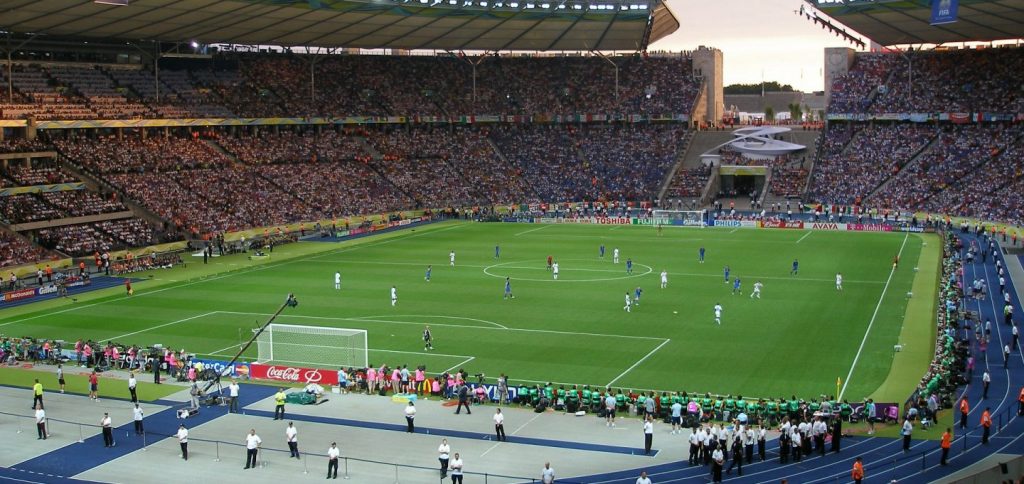The beverage industry and sports marketing: a match made in heaven

This year’s calendar is just brimming with major international sporting events. Now that the Handball World Championship and the Winter Olympics have wrapped up, the FIFA World Cup in Russia is just around the corner. Kicking off in mid-June, the event will feature 64 matches for fans to enjoy all around the world— and pose a real opportunity for the beverage industry. Ultimately, major events of this kind present a huge chance for launching far-reaching marketing campaigns. Alone in terms of its very wide target audience that spans all age groups, soccer intrinsically constitutes an exceedingly attractive advertising environment for the beverage industry. There’s just no denying: The industry can significantly profit from major sporting events.
Even without advertising, beer sales evidently soar thanks to the FIFA World Cup. Fans do, however, also select soft drinks as well. No matter if they are glued to their televisions at home or watch at a public screening, fans seem to make drinking an integral part of the whole experience. So, for example, when the World Cup kicked off in Brazil in June 2014, Germany alone experienced beer sales that rose by 14% compared with June 2013. Taking the first half of 2014 as a whole, sales were 4.4% higher than in the same period the year before. Beer-based mixed drinks were also extremely popular, with more than 125,000 more hectoliters sold in June 2014 than in June 2013 — an increase of nearly 27%. FIFA’s plan to expand the number of competing teams to 48 starting in 2026 has received a lot of criticism. For the beverage industry, however, more matches and more competing nations mean an opportunity to boost sales as the number of potential spectators, viewers, and customers will automatically skyrocket.
Even non-FIFA partners have room to get creative
The bottom line is this: Specific World Cup marketing campaigns have to comply with FIFA’s stringent guidelines. The international governing body for the sport applies very strict usage provisions. For example, the official World Cup logo, the event name, the World Cup trophy, the mascot, and even the match schedule are trademark protected and cannot be used without permission. Of course, there’s nothing to stop people from coming up with creative marketing ideas using general soccer motifs and slogans. They should, however, pay close attention to the rules. After all, this is no laughing matter for FIFA: Official partners and sponsors pay a lot of money for their advertising rights. The beverage industry is currently represented by Budweiser and Coca-Cola. Nonsponsors still make good use of the World Cup, though. For example, in 2014 PepsiCo launched an ad campaign featuring Lionel Messi and other soccer stars that had been filmed in the then host nation of Brazil and used in around 100 countries. But the World Cup wasn’t just dominated by the big names in the industry: Many small and midsized beverage companies also demonstrated how imaginative they could be when they introduced successful campaigns of their own. These ranged from TV ads and creative drink names to collectible bottle caps and point-of-sale promotions.
Digital campaigns are a must for the beverage industry
Today, making the best possible use of sporting events as platforms to attract customers and fans over the long term means creating a link between digital content and the corresponding real world of experience. For example, Budweiser, an official sponsor of the 2014 World Cup, engaged mobile-device users by enabling fans to vote for their favorite players using Twitter Cards. In a more recent example, this year’s Winter Olympics saw the introduction of another digital innovation: To reach younger audiences in greater numbers, a group that accesses a lot of content through other channels than television, Discovery subsidiary Eurosport teamed up with Snap to form an advertising partnership. They primarily focused on delivering the latest trend sports as well as glimpses behind the scenes, digital features, and collaborations with influencers.
Sports marketing: tapping into the entire sports market
Sports environments outside of major sporting events are also popular with the beverage industry. The Thai energy-drink manufacturer Carabao has, for example, been one of the main sponsors of Chelsea F.C. for several years now in a bid to attract attention on an international stage. But it’s not just the king of sports that offers the promise of success. Thanks to the internet, the beverage industry also has an excellent platform for reaching its customers through minority sports and mass sports. Millions of users access digital sports content every month. Whether involving video advertising, sponsorship of individual types of sports, or working directly with individual sports personalities, beverage companies can tap immense opportunities through the internet. Sports marketing exists at all levels. The trick is to make the right choice. An immense number of people are interested in sports and many even like to participate themselves. But companies need to heed a general rule: Sports marketing will not see long-term success
